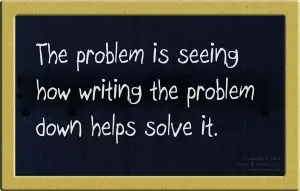How Can Writing Down The Problem Help Solve It?
One of the best problem-solving techniques I learned is writing down the problem. Doing this as detailed as possible helps by:
- Putting the problem in a form that allows us to see it
- Uncovering aspects of the problem we had not considered
- Encouraging us to think about the problem as we choose the right words
- Ensuring everyone is tackling the same problem in brainstorming sessions

Writing down the problem does help to solve it by involving other senses.
Example of Writing Down the Problem
My most successful use of writing down the problem involved the design of a week-long seminar for top sales reps regarding some new product lines. I worked with the National Sales Manager to define the problem based upon the questions his people were asking.
In the end, we came up with this questions. It became my working definition for the problem of addressing our sales people’s needs:
How do we integrate our various products into our story and our presentations?
Example of How Writing Down the Problem Solves Problems
Looking at this definition, let’s contrast it with sales in general. Since the question is “how,” that means process. So, looking at the sales process, this question involves telling the story and making presentations, just two parts of the process.
Challenging Assumptions
Contrasting involves not only looking at similarities but differences. What’s missing? An important part is the questioning step. To sell effectively one must understand the problem. Sales jargon often uses the word “need” here. Finding the need involves questioning.
In short, writing down the problem tells us to challenge the assumption that the training solution is about telling the story and making presentations better. Perhaps questioning better or differently holds the key. Of course, this did not pop up right away. The question did say to check the story and presentations too.
Forming the Solution
In the end, we decided to focus on questioning. The key premise was that the questions one asks say much about what she’s selling. They also impact the sale itself.
Therefore, an integrated product line requires integrated questioning. However, each sales person had his pet products to sell. Thus, his questions centered around those products. The training showed how this method trapped the salesperson. It also showed how to question to expand opportunities and success.
The sales reps received the training well. A few even took the presentation to show to their servicing teams. As for the eighteen product managers, their focus was on questions the reps could use to uncover problems.
So, by writing down the problem, we could see something missing. That became the solution . . . and success.



Mike, this is a great idea. I saw your blog post this morning on my Linkedin Page, and hadn’t known you were writing this blog. I look forward to reading it regularly.
It sounds like you were able to help the reps get to the clients’ true needs, then present a product to meet those needs, vs. presenting products that met resistance because needs hadn’t been clarified.
It’s a great technique. I particularly like the putting the problem into a form so people can see it. I like to get people to draw the problem without using any words. It can illuminate the nature of the problem in ways that words don’t. Sometime problems are very simple but hidden behind assumptions and habitual thinking.
So true, Andy. The idea of drawing the problem without words is great! It also allows you to see better how people feel about the problem too. Thank you for visiting. Great thoughts. ~Mike
Really good ideas and advice. Thanks for everything, we can read and learn from you.
Thank you, Olgica, for the compliment. I’m pleased you find the information helpful. ~Mike